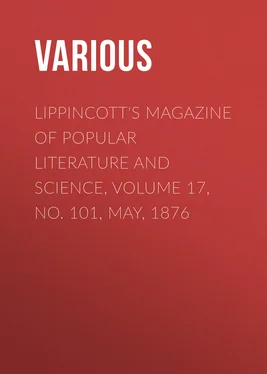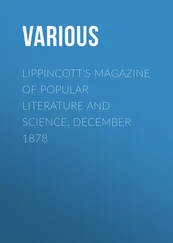Various - Lippincott's Magazine of Popular Literature and Science, Volume 17, No. 101, May, 1876
Здесь есть возможность читать онлайн «Various - Lippincott's Magazine of Popular Literature and Science, Volume 17, No. 101, May, 1876» — ознакомительный отрывок электронной книги совершенно бесплатно, а после прочтения отрывка купить полную версию. В некоторых случаях можно слушать аудио, скачать через торрент в формате fb2 и присутствует краткое содержание. Издательство: Иностранный паблик, Жанр: foreign_antique, periodic, foreign_edu, на английском языке. Описание произведения, (предисловие) а так же отзывы посетителей доступны на портале библиотеки ЛибКат.
- Название:Lippincott's Magazine of Popular Literature and Science, Volume 17, No. 101, May, 1876
- Автор:
- Издательство:Иностранный паблик
- Жанр:
- Год:неизвестен
- ISBN:нет данных
- Рейтинг книги:3 / 5. Голосов: 1
-
Избранное:Добавить в избранное
- Отзывы:
-
Ваша оценка:
- 60
- 1
- 2
- 3
- 4
- 5
Lippincott's Magazine of Popular Literature and Science, Volume 17, No. 101, May, 1876: краткое содержание, описание и аннотация
Предлагаем к чтению аннотацию, описание, краткое содержание или предисловие (зависит от того, что написал сам автор книги «Lippincott's Magazine of Popular Literature and Science, Volume 17, No. 101, May, 1876»). Если вы не нашли необходимую информацию о книге — напишите в комментариях, мы постараемся отыскать её.
Lippincott's Magazine of Popular Literature and Science, Volume 17, No. 101, May, 1876 — читать онлайн ознакомительный отрывок
Ниже представлен текст книги, разбитый по страницам. Система сохранения места последней прочитанной страницы, позволяет с удобством читать онлайн бесплатно книгу «Lippincott's Magazine of Popular Literature and Science, Volume 17, No. 101, May, 1876», без необходимости каждый раз заново искать на чём Вы остановились. Поставьте закладку, и сможете в любой момент перейти на страницу, на которой закончили чтение.
Интервал:
Закладка:
Various
Lippincott's Magazine of Popular Literature and Science, Volume 17, No. 101, May, 1876
THE CENTURY—ITS FRUITS AND ITS FESTIVAL
V.—MINOR STRUCTURES OF THE EXHIBITION
Compress it as you may, this globe of ours remains quite a bulky affair. The world in little is not reducible to a microscopic point. The nations collected to show their riches, crude and wrought, bring with them also their wants. For the display, for its comfort and good order, not only space, but a carefully-planned organization and a multiplicity of appliances are needed. Separate or assembled, men demand a home, a government, workshops, show-rooms and restaurants. For even so paternal and, within its especial domain, autocratic a sway as that of the Centennial Commission to provide all these directly would be impossible. A great deal is, as in the outer world, necessarily left to private effort, combined or individual.
Having in our last paper sketched the provision made by the management for sheltering and properly presenting to the eye the objects on exhibition, we shall now turn from the strictly public buildings to the more numerous ones which surround them, and descend, so to speak, from the Capitol to the capital.
Our circuit brought us back to the neighborhood of the principal entrance. Standing here, facing the interval between the Main Building and Machinery Hall, our eyes and steps are conducted from great to greater by a group of buildings which must bear their true name of offices, belittling as a title suggestive of clerks and counting-rooms is to dimensions and capacity exceeding those of most churches. Right and left a brace of these modest but sightly and habitable-looking foot-hills to the Alps of glass accommodate the executive and staff departments of the exposition. They bring together, besides the central administration, the post, police, custom-house, telegraph, etc. A front, including the connecting verandah, of five hundred feet indicates the scale on which this transitory government is organized. Farther back, directly opposite the entrance, but beyond the north line of the great halls, stands the Judges' Pavilion. In this capacious "box," a hundred and fifty-two by a hundred and fifteen feet, the grand and petit juries of the tribunal of industry and taste have abundant elbow—room for deliberation and discussion. The same enlightened policy which aimed at securing the utmost independence and the highest qualifications of knowledge and intelligence in the two hundred men who determine the awards, recognized also the advantage of providing for their convenience. Their sessions here can be neither cramped nor disturbed. So far as foresight can go, there is nothing to prevent their deciding quietly, comfortably and soundly, after mute argument from the vast array of objects submitted to their verdict, on the merits of each. The main hall of this building, or high court as it may be termed, is sixty by eighty feet, and forty-three feet high. In the rear of it is a smaller hall. A number of other chambers and committee-rooms are appropriated to the different branches as classified. Accommodation is afforded, besides, to purposes of a less arid nature—fêtes, receptions, conventions, international congresses and the like. This cosmopolitan forum might fitly have been modeled after
the tower that builders vain,
Presumptuous, piled on Shinar's plain.
Bricks from Birs Nimroud would have been a good material for the walks. Perhaps, order being the great end, anything savoring of confusion was thought out of place.
Fire is an invader of peace and property, defence against whose destructive forays is one of the first and most constant cares of American cities, old and new, great and small. Before the foundations of the Main Building were laid the means of meeting the foe on the threshold were planned. The Main Building alone contains seventy-five fire-plugs, with pressure sufficient to throw water over its highest point. Adjacent to it on the outside are thirty-three more. Seventy-six others protect Machinery Hall, within which are the head-quarters of the fire service. A large outfit of steam fire-engines, hose, trucks, ladders, extinguishers and other appliances of the kind make up a force powerful enough, one would think, to put out that shining light in the records of conflagration—Constantinople. Steam is kept up night and day in the engines, which, with their appurtenances, are manned by about two hundred picked men. The houses for their shelter, erected at a cost of eight thousand dollars, complete, if we except some architectural afterthoughts in the shape of annexes, the list of the buildings erected by the commission.
Place aux dames! First among the independent structures we must note the Women's Pavilion. After having well earned, by raising a large contribution to the Centennial stock, the privilege of expending thirty-five thousand dollars of their own on a separate receptacle of products of the female head and hand, the ladies selected for that a sufficiently modest site and design. To the trait of modesty we cannot say that the building has failed to add that of grace. In this respect, however, it does not strike us as coming up to the standard attained by some of its neighbors. The low-arched roofs give it somewhat the appearance of a union railway-depot; and one is apt to look for the emergence from the main entrances rather of locomotives than of ladies. The interior, however is more light and airy in effect than the exterior. But "pretty is that pretty does" was a favorite maxim of the Revolutionary dames; and the remarkable energy shown by their fair descendants, under the presidency of Mrs. E. D. Gillespie, in carrying through this undertaking will impart to it new force. The rule is quite in harmony with it that mere frippery should be avoided within and without, and the purely decorative architect excluded with Miss McFlimsey. The ground-plan is very simple, blending the cross and the square. Nave and transept are identical in dimensions, each being sixty-four by one hundred and ninety-two feet. The four angles formed by their intersection are nearly filled out by as many sheds forty-eight feet square. A cupola springs from the centre to a height of ninety feet. An area of thirty thousand square feet strikes us as a modest allowance for the adequate display of female industry. For the filling of the vast cubic space between floor and roof the managers are fain to invoke the aid of an orchestra of the sterner sex to keep it in a state of chronic saturation with music.
Reciprocity, however, obtains here. The votaries of harmony naturally seek the patronage of woman. Her territorial empire has accordingly far overstepped the narrow bounds we have been viewing. The Women's Centennial Music Hall on Broad street is designed for all the musical performances connected with the exposition save those forming part of the opening ceremonies. This is assuming for it a large office, and we should have expected so bold a calculation to be backed by floor-room for more than the forty-five hundred hearers the hall is able to seat. A garden into which it opens will accommodate an additional number, and may suggest souvenirs of al-fresco concerts to European travelers.
Nor does the sex extend traces of its sway in this direction alone. A garden of quite another kind, meant for blossoms other than those of melody, and still more dependent upon woman's nurture, finds a place in the exposition grounds near the Pavilion. Of the divers species of Garten — Blumen-, Thier-, Bier -, etc.—rife in Vaterland, the Kinder – is the latest selected for acclimation in America. If the mothers of our land take kindly to it, it will probably become something of an institution among us. But that is an
Читать дальшеИнтервал:
Закладка:
Похожие книги на «Lippincott's Magazine of Popular Literature and Science, Volume 17, No. 101, May, 1876»
Представляем Вашему вниманию похожие книги на «Lippincott's Magazine of Popular Literature and Science, Volume 17, No. 101, May, 1876» списком для выбора. Мы отобрали схожую по названию и смыслу литературу в надежде предоставить читателям больше вариантов отыскать новые, интересные, ещё непрочитанные произведения.
Обсуждение, отзывы о книге «Lippincott's Magazine of Popular Literature and Science, Volume 17, No. 101, May, 1876» и просто собственные мнения читателей. Оставьте ваши комментарии, напишите, что Вы думаете о произведении, его смысле или главных героях. Укажите что конкретно понравилось, а что нет, и почему Вы так считаете.












